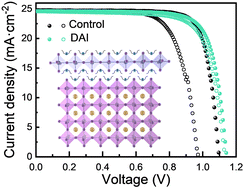In situ surface regulation of 3D perovskite using diethylammonium iodide for highly efficient perovskite solar cells†
Abstract
Surface passivation by constructing a 2D/3D structure is considered to be an effective strategy for suppressing non-radiative recombination and improving the device efficiency and stability. Herein, the 2D perovskite is formed in situ on the surface of a 3D perovskite via chemical interactions between diethylammonium iodide (DAI) and Pb–I octahedra, which greatly reduces the deep level defects and non-radiative recombination. Moreover, the 2D/3D structure can regulate the energy level alignment, enhance the charge extraction, and improve the open-circuit voltage. Finally, compared with the control device, the power conversion efficiency (PCE) of the DAI-treated device increases from 21.58 to 23.50%. The unencapsulated devices stored in air for more than 500 hours can still retain 97% of their initial PCE, revealing good long-term placement stability. This work provides a promising strategy to fabricate efficient PSCs through the in situ construction of 2D/3D perovskite heterojunctions.



 Please wait while we load your content...
Please wait while we load your content...